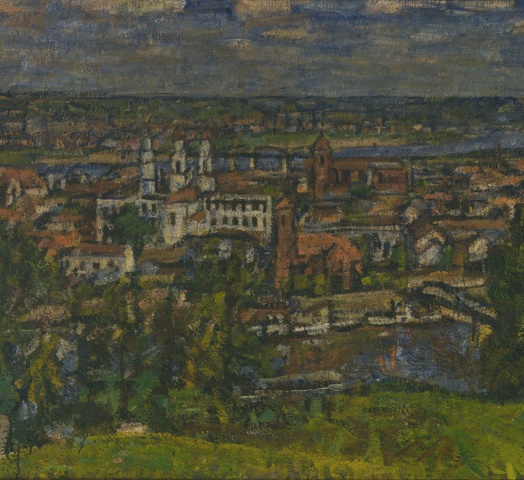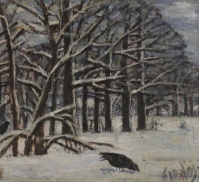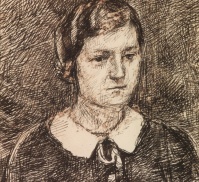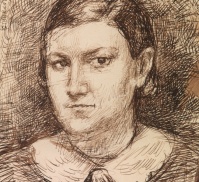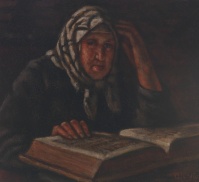AN EXHIBITION OF VLADAS EIDUKEVIČIUS "THE NOMAD ARTIST"
On 18th Feburary at 4 p.m. an exhibition of Vladas Eidukevičius “The Nomad Artist”, dedicated to the 125th anniversary from the artist’s birth, will open its doors at Vilnius Picture Gallery (Didžioji St. 4).
Major exhibitions of Vladas Eidukevičius' work have been held in Lithuania on numerous occasions – at the Lithuanian Art Museum (1963, 1982, 1991) and the National M. K. Čiurlionis Art Museum (1982). Aside from works displayed earlier, this exhibition also features some of the painter's works newly acquired by the museum, as well as paintings from the private collections of Rolandas Valiūnas (Forest in winter, 1924–1925, In the park, 1912, Double portrait of a girl, 1936, Old woman and the Holy Scriptures, 1930, Kaunas from the Aleksotas hill, 1930, Flowers in a vase, 1930) and Algimantas Miškinis. A larger portion of the exhibition consists of portraits, compositions and landscapes created in the 1920s–1930s. They feature a generalised, classic and laconic composition style, a richly coloured palette, and a complex multi-layered texture. The works of Eidukevičius presented at this exhibition constitute but a small fraction of the enormous creative legacy left scattered around Europe, remaining a mystery to society to this day.
Vladas Eidukevičius (1891–1941) was one of the most famous interwar Lithuanian painters, whose work is like a bridge between classic and modern painting. According to Antanas Gudaitis, he was the only Lithuanian artist to have merged Lithuanian painting with Western traditions, without losing his authenticity.
He was born on August 9, 1891 to Juozas and Juzefa Eidukevičius in Kaunas. Whilst still quite young, he and his parents moved to Riga is search of work. He attended the studio of Bernhard Borchert in 1906, later entering the Riga Art School, where he studied painting with Jan Rozental. He studied art independently in Saint Petersburg and Moscow in the years 1910–1912, copying paintings in the cities' museums.
In 1913–1918 he lived in Germany, in Berlin, Munich and Heidelberg. He attended the Munich Art Academy for half a year. When the First World War started, he was interned as he was considered a Russian citizen. He had to spend the entire war in Berlin, earning a living by making copies of paintings? When the war ended he travelled around Europe – he had the chance to visit Holland, Switzerland, Italy and France. Always on the move, he would often return to Riga where he held several solo exhibitions. He settled in France for a while, living in various places. Whilst in Paris in 1926 he met with Kazys Šimonis and Vladas Grybas. At the beginning of 1927 he established contact with Mstislav Dobuzhinski, exchanging letters. An exhibition of Vladas Eidukevičius' work was held in one of the Paris salons in Montmartre in November–December, 1928. Before it ended, the artist travelled to Basel, Switzerland, then by train to Livorno, Italy. From there he sailed to Corsica, where, according to Dobuzhinski, he visited several times. The paintings produced on this island marked the beginning of a new creative period. In 1929 he made a brief return to Riga. The artist never stayed in any one place very long, always searching for new creative impulses kept him on the move.
Eidukevičius arrived in Lithuania in the spring of 1932 and settled down in Kaunas. Yet even living there he would sometimes depart on a journey. Nevertheless, it was in Lithuania that the artist sensed his creative maturity flourishing. In his autobiography, the artist wrote: “In Lithuania the purpose of my work became clearer, my technique matured, the combination of paints levelled out, [...] my art grew”.
He started appearing in art shows from 1911. Solo exhibitions were held in Riga (1922, 1929), Paris (1928), Kaunas (1934) and Klaipėda (1939). Whilst living in Lithuania, the artist was a regular participant in Lithuanian artists' exhibitions. Despite being a member of the Lithuanian Artists' Union, as a true individualist, he did not belong to any particular art group. He kept his distance from interwar art streams and the hustle and bustle of artists' unions and activities from that time.
There is some uncertainty surrounding the circumstances behind the artist's death. Based on his contemporaries' accounts and some surviving documents, it is believed that he died on June 22 or 23, 1941 in Aleksotas, Kaunas. A special committee was formed following his death, which had to look after the artist's remaining paintings (120 canvases).
Eidukevičius was not very concerned over the fate of his paintings, as it appears most of them were left on roadsides around Europe, scattered, never to be returned to one place. The artist brought back only fragments of his earlier work with him to Kaunas. These earlier works, judging by some later works dated to 1918, could have been modestly generalised shapes of a dimmed brownish palette. A great influence of the German expressionists is felt in his works painted whilst he was living in Berlin, from whom he adopted an energetic, broad, pastoso manner. Eidukevičius' works may be found in Latvia, Germany, France, also in Russia – the artist would leave them in return for food and board. Not all of the paintings made in Lithuania survived either, as the whereabout of only a small portion of his work is known. The artist himself has said that if all his paintings were ever collected in one place, laid out they would reach from Klaipėda to Palanga. The largest and most valuable collection of Vladas Eidukevičius' works (164 paintings) is kept at the Lithuanian Art Museum. Some are kept at the National M. K. Čiurlionis Art Museum (31), and one each at the Kaunas City Museum's M. and K. Petrauskas Lithuanian Music Department and the Šiauliai “Aušra” Museum, with several belonging to private collections.
Curator Rima Rutkauskienė
The exhibition will run until 17th April
Info: Lithuanian Art Museum

On 18th Feburary at 4 p.m. an exhibition of Vladas Eidukevičius “The Nomad Artist”, dedicated to the 125th anniversary from the artist’s birth, will open its doors at Vilnius Picture Gallery (Didžioji St. 4).
Major exhibitions of Vladas Eidukevičius' work have been held in Lithuania on numerous occasions – at the Lithuanian Art Museum (1963, 1982, 1991) and the National M. K. Čiurlionis Art Museum (1982). Aside from works displayed earlier, this exhibition also features some of the painter's works newly acquired by the museum, as well as paintings from the private collections of Rolandas Valiūnas (Forest in winter, 1924–1925, In the park, 1912, Double portrait of a girl, 1936, Old woman and the Holy Scriptures, 1930, Kaunas from the Aleksotas hill, 1930, Flowers in a vase, 1930) and Algimantas Miškinis. A larger portion of the exhibition consists of portraits, compositions and landscapes created in the 1920s–1930s. They feature a generalised, classic and laconic composition style, a richly coloured palette, and a complex multi-layered texture. The works of Eidukevičius presented at this exhibition constitute but a small fraction of the enormous creative legacy left scattered around Europe, remaining a mystery to society to this day.
Vladas Eidukevičius (1891–1941) was one of the most famous interwar Lithuanian painters, whose work is like a bridge between classic and modern painting. According to Antanas Gudaitis, he was the only Lithuanian artist to have merged Lithuanian painting with Western traditions, without losing his authenticity.
He was born on August 9, 1891 to Juozas and Juzefa Eidukevičius in Kaunas. Whilst still quite young, he and his parents moved to Riga is search of work. He attended the studio of Bernhard Borchert in 1906, later entering the Riga Art School, where he studied painting with Jan Rozental. He studied art independently in Saint Petersburg and Moscow in the years 1910–1912, copying paintings in the cities' museums.
In 1913–1918 he lived in Germany, in Berlin, Munich and Heidelberg. He attended the Munich Art Academy for half a year. When the First World War started, he was interned as he was considered a Russian citizen. He had to spend the entire war in Berlin, earning a living by making copies of paintings? When the war ended he travelled around Europe – he had the chance to visit Holland, Switzerland, Italy and France. Always on the move, he would often return to Riga where he held several solo exhibitions. He settled in France for a while, living in various places. Whilst in Paris in 1926 he met with Kazys Šimonis and Vladas Grybas. At the beginning of 1927 he established contact with Mstislav Dobuzhinski, exchanging letters. An exhibition of Vladas Eidukevičius' work was held in one of the Paris salons in Montmartre in November–December, 1928. Before it ended, the artist travelled to Basel, Switzerland, then by train to Livorno, Italy. From there he sailed to Corsica, where, according to Dobuzhinski, he visited several times. The paintings produced on this island marked the beginning of a new creative period. In 1929 he made a brief return to Riga. The artist never stayed in any one place very long, always searching for new creative impulses kept him on the move.
Eidukevičius arrived in Lithuania in the spring of 1932 and settled down in Kaunas. Yet even living there he would sometimes depart on a journey. Nevertheless, it was in Lithuania that the artist sensed his creative maturity flourishing. In his autobiography, the artist wrote: “In Lithuania the purpose of my work became clearer, my technique matured, the combination of paints levelled out, [...] my art grew”.
He started appearing in art shows from 1911. Solo exhibitions were held in Riga (1922, 1929), Paris (1928), Kaunas (1934) and Klaipėda (1939). Whilst living in Lithuania, the artist was a regular participant in Lithuanian artists' exhibitions. Despite being a member of the Lithuanian Artists' Union, as a true individualist, he did not belong to any particular art group. He kept his distance from interwar art streams and the hustle and bustle of artists' unions and activities from that time.
There is some uncertainty surrounding the circumstances behind the artist's death. Based on his contemporaries' accounts and some surviving documents, it is believed that he died on June 22 or 23, 1941 in Aleksotas, Kaunas. A special committee was formed following his death, which had to look after the artist's remaining paintings (120 canvases).
Eidukevičius was not very concerned over the fate of his paintings, as it appears most of them were left on roadsides around Europe, scattered, never to be returned to one place. The artist brought back only fragments of his earlier work with him to Kaunas. These earlier works, judging by some later works dated to 1918, could have been modestly generalised shapes of a dimmed brownish palette. A great influence of the German expressionists is felt in his works painted whilst he was living in Berlin, from whom he adopted an energetic, broad, pastoso manner. Eidukevičius' works may be found in Latvia, Germany, France, also in Russia – the artist would leave them in return for food and board. Not all of the paintings made in Lithuania survived either, as the whereabout of only a small portion of his work is known. The artist himself has said that if all his paintings were ever collected in one place, laid out they would reach from Klaipėda to Palanga. The largest and most valuable collection of Vladas Eidukevičius' works (164 paintings) is kept at the Lithuanian Art Museum. Some are kept at the National M. K. Čiurlionis Art Museum (31), and one each at the Kaunas City Museum's M. and K. Petrauskas Lithuanian Music Department and the Šiauliai “Aušra” Museum, with several belonging to private collections.
Curator Rima Rutkauskienė
The exhibition will run until 17th April
Info: Lithuanian Art Museum






